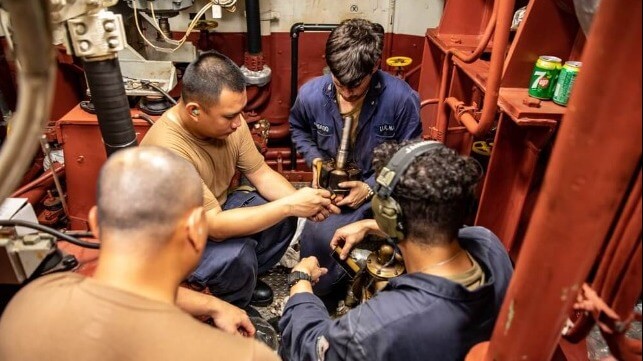GAO: Understaffed, Overworked Crews Slow Down U.S. Navy Maintenance

In a new study of the U.S. Navy's routine in-port repair operations - known in the service as intermediate availability periods - the Government Accountability Office (GAO) identified significant challenges for timely completion of regular maintenance, with implications for readiness.
The most serious challenge appears to be a shortage of qualified technical personnel, increasing the burden on the remaining crewmembers. 10 out of 16 ships' crews interviewed by GAO reported that the resulting workload pressures are so severe that they "lead to mental health and morale issues that may result in sailors taking leave for medical reasons, such as to receive mental health evaluations, which further increases crew shortages."
Several crews reported when an overworked crewmember had to depart for mental health reasons, the vacant personnel slot might remain unfilled for months. "Members of one ship’s crew stated that they lost one person to suicide and a dozen other personnel experienced mental health issues over a period of seven months," GAO wrote.
The report of crew short-staffing is consistent with past studies. In inquiries after the deadly collisions involving USS Fitzgerald and USS John S. McCain in 2017, investigators cited the same personnel shortage as a key contributing factor, along with overtasking and under-training.
In the GAO study, crews also reported limited maintenance training, high operational tempos, long work hours and a shortage of spare parts. "According to five of 16 ships’ crews, challenges obtaining parts and materials led them to resort to using work-arounds, which several crewmembers characterized as unorthodox engineering or using 'duct-tape' and 'bubble-gum' approaches to get systems and equipment in 'good enough' condition to function and get underway," GAO found. "When they cannot locate inexpensive parts or consumable items through standard channels, they might purchase the items themselves, adapt available materials to address their needs, or adapt parts from other ships to their own."
GAO found that long-running staff shortages also exist in shoreside units with maintenance responsibilities. 15 of the 18 Navy organizations with involvement in intermediate maintenance periods told the agency that they were short-handed, and officials reported that 20 percent undermanning at shoreside maintenance units has been common for several years.
The full impact of these challenges is hard to assess because Navy does not accurately track intermediate maintenance, despite a policy requiring recordkeeping, according to GAO. The records on surface ships and aircraft carriers were too unreliable for the purposes of the study, even after GAO "asked Navy officials to explain any discrepancies or outliers that we encountered." GAO only identified one dataset - on submarine maintenance start and completion dates - that was "sufficiently reliable" to be useful for the report. That data showed that over 2015-2020, submarine intermediate maintenance was completed late about 46 percent of the time, adding up to about seven vessel-years (2,500 days) of delay.
